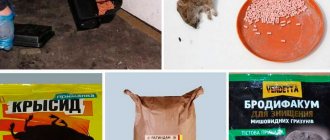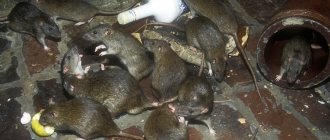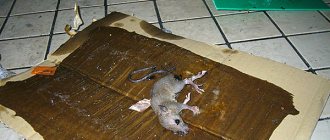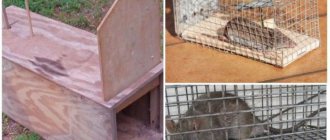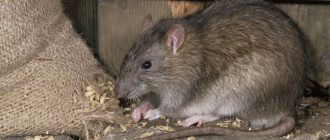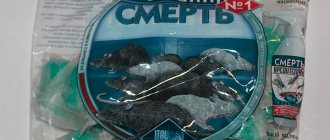Almost always, when the fight against rodents begins, the question arises of choosing an effective bait for rats (and mice as well). This can be either a special poisoned bait that the pest must eat, or simply a certain food product that rats love and which is placed in the trap to effectively attract rodents.
And practice shows that the more attractive the bait is to rats, the sooner they can be poisoned or caught. The animal's desire to eat must be stronger than the fear of an unusual design or suspicion of a new food product.
Accordingly, the question arises of what rats love most. At the same time, thanks to cartoons, there is a widespread misconception that rats and mice love cheese most of all, but in reality this is just a myth - yes, they will eat it, but they may not climb into a trap for it.
Ground meat? Milk? It’s already warmer, but these products are not at all the most favorite delicacy of rodents.
The task is further complicated by the fact that populations of rodents living in different conditions (in a private house, in a sewer, in a garden plot or in a garbage dump) may have their own food preferences. However, through the practice and experience of many rodent control agents, the best baits for rats have been found, which almost always work effectively. We will talk about them in more detail later...
What do rats and mice like?
Both professional rodent exterminators who kill rodents almost every day and biologists who study these animals are well aware that rats mainly love animal products, while mice prefer plant foods . Moreover, this is not a strict rule, but rather a general characteristic of food preferences: for example, mice are also often not averse to eating a piece of lard or meat, and rats, with all their love for meat food, will not refuse grain, and when hungry, even a piece apple
On a note
It is not without reason that many enterprises use poisoned barley to fight rats - not the best bait, but more or less effective, especially when rodents have no other food available.
With that said, some good rat bait options include the following:
- Salo;
- Sausage;
- Ground meat;
- Egg;
- Fish;
- Cheese.
As for mice, bait for them can be as follows:
- A piece of apple or pear;
- A piece of peach or apricot;
- A piece of plum;
- Fresh bread (preferably moistened with sunflower oil);
- Porridge (boiled).
It often happens that certain baits literally hypnotize rats, but mice remain absolutely indifferent to them. Therefore, when deciding what to put in a trap, you need to clearly understand who exactly you plan to lure into this trap: a rat or a mouse.
On a note
A common situation: the owner of the apartment finds nibbled bread or cereal spilled from a bag, but does not know for sure whether it is a rat or a mouse. And a trap with a piece of apple for a mouse can stand untouched for several days, disappointing the owner of the premises, while a little rat lives quietly in the house, indifferent to this bait.
Conclusion: if you are not sure whether rats or mice are in charge of the house, then it is advisable to test different types of bait, choosing products of both plant and animal origin (or put both types of bait in the trap at the same time).
This nuance is also important: not every bait is convenient to put in a trap, just as it is not advisable to mix every rat treat with poison. Therefore, some baits are suitable for one method of fighting, and others are suitable for another.
Let's see what makes sense to use and in what cases.
Fishing principles
Rats get used to one familiar bait. This means that it should not be kept in a rat trap for more than 3 days in a row.
It is better to replace it with a new bait more often in order to lure it out and not cause alertness or suspicion in the rat. Despite the fact that the animals are omnivores, they still like to give preference to their favorite foods, rushing into the trap
If mechanical traps are used, it is important to place them near the walls and block access to them for children and pets. It is worth keeping rat traps clean at all times.
Handle them only with gloves. Regularly remove food products from the kitchen, leaving no food sources other than a mousetrap. Store cereals in glass or metal jars.
Attracting rats to traps
Often one of the main requirements for baits used in rat traps is a dense consistency. The fact is that in many traps you need to place a treat on a hook - the animal will pull it and release the corresponding mechanism. It is clear that minced meat or egg yolk are not suitable for such cases.
The second requirement is a strong smell. The rat, even being far from the trap, must inevitably want to try the treat and be ready to overcome its caution and fear.
The following rat baits have worked well in this regard:
- Smoked sausage;
- Cold smoked fish;
- Lard (ideally with the edge singed over the fire);
- Cheese (preferably smoked);
- A crust of bread, sprinkled with vegetable oil (preferably unrefined, strong-smelling).
The photo below shows an example of a mousetrap in which a rat was caught on a piece of sausage:
However, there are also traps that are triggered by the weight of the animal. They do not require the rat to pull the bait; it is only important to attract the pest and force it to climb inside the trap. In these cases, you can use not only the baits listed above, but also, for example, the following:
- Raw minced meat (preferably with onions);
- Roasted seeds or nuts;
- Chocolate.
It is also useful to read: How to get rid of rats in a chicken coop if they have gotten into the habit of stealing eggs
If some bait does not attract rats or mice for more than three or four days (especially when the trap itself is set every night in a new place), then such bait must be replaced. In addition, even a well-functioning bait is useful to replace with a fresh one every day or two - its smell gradually weakens and it attracts rats less well.
This is especially important for tunnel traps (and other partially enclosed structures) - the aroma of the treat must be strong enough to escape from the trap and spread throughout the room, which happens more slowly than, for example, from open mousetraps.
Another important point that many rodent fighters do not take into account: at any stage of working with bait, it is highly recommended not to touch it with bare hands, otherwise the human smell will repel rodents.
Salo
When asked what mice love most, experts answer lard. Rodents can easily recognize high-calorie foods, which they can fill up quickly and for a long time. Lard is considered the most effective assistant in catching mice. To enhance its attractiveness, the treat is lightly fried with a match to make the smell more captivating. It is necessary to use fresh lard with an attractive aroma; the smell of old and stale lard repels them.
To save money, you can put the skin with the remaining lard in the rat trap. Such bait will not deteriorate for a long time and will retain an appetizing smell for the mouse.
Baits for preparing poison for rats
In order to prepare an effective poison for rats at home (for example, based on Zookoumarin or Krysid), it is advisable to use baits in which the poison can be easily homogenized with the food base.
For example, the following bait bases are good for both rats and mice in this regard:
- Beer, oddly enough, is what rats and mice often cannot resist;
- Milk;
- Meat broth soup;
- Again, raw minced meat, preferably with lard and onions;
- Finely chopped boiled egg;
- Dough with seasonings and spices;
- Boiled porridge, especially with vegetable oil.
Poison is simply added to the food base in the proportions indicated for each drug in the instructions, and the entire mixture is thoroughly mixed. After this, the finished poisoned bait is laid out on a cardboard or saucer (in the case of liquid agents, poured into a plate) and placed where the rats are most likely to quickly find it. All work is carried out wearing rubber gloves.
It is important to take measures to ensure that pets and children cannot reach such bait. This will be discussed in more detail below.
On a note
The vast majority of industrially produced rat poisons are made from dough. Its beauty lies in the fact that the bait turns out to be quite dense, but at the same time not hard, does not fall apart and does not leave marks. In addition, dough briquettes can be easily placed almost anywhere and are much more convenient than bowls of soup or milk.
Take, for example, such products as Mortorat, Rat Death No. 1 and No. 2, Absolon, Ratobor, etc. - these are flavored dough briquettes with blood anticoagulants as the active substance (anticoagulants are one of the most effective rat poisons today). Such a briquette can be placed even in the most inaccessible places, where a saucer with liquid bait will definitely not fit.
However, at home, instead of dough, it is often preferable to use minced meat, which rats love more and which, due to its own strong odor, does not require the addition of flavorings.
A strong smell is also needed to mask the aroma of poison in the bait. Rats are very suspicious and have a very keen sense of smell. If they suspect the presence of a dangerous impurity in a treat (or a human smell), then they will never touch it. Therefore, the stronger the smell of the food base, the greater the likelihood that the rat will be poisoned.
Powdered poisons
Below you can see several good recipes with powdered poisons that will help you quickly catch rats:
- Boil a kilogram of oatmeal or wheat cereal until smooth, add 10 g. Rat. Mix;
- Mix 100-150 g of minced meat (fish or meat, it doesn’t matter), 800 g of finely chopped bread and 50 g of Zookoumarin into a homogeneous mass;
- Mix 900 g of finely chopped bread, 150 g of vegetable or butter and 10 g of Rat into a homogeneous mass;
- Mix 650 g of finely chopped bread, 100 g of mashed potatoes, 60 g of vegetable or butter and 20 g of Ratindane;
- Mix 100 g of chopped onion, pre-fried in oil, 900 g of finely chopped bread and 40 g of Ratindan.
Of course, like everything in this world, poison baits have their drawbacks, but even with them, these are the best baits you can come up with for catching rats at home.
Recipes for preparing poison for rats with different baits and poisons
Generally speaking, recipes for poisoned baits for killing rats and mice can be very diverse; it is only important to adhere to the rules noted above when choosing a food base and observe the proportions indicated in the instructions for using the corresponding poison (so that the rat does not notice the danger).
Here are several ready-made recipes that have been tested many times in practice and in most cases give good results when fighting rats:
- 100 grams of minced meat (no matter meat or fish), 850 grams of crushed bread and 50 grams of Zookoumarin;
- 870 grams of crushed bread, 100 grams of onions fried in vegetable oil, and 30 grams of Ratindan;
- 890 grams of crushed bread, 100 grams of vegetable oil and 100 grams of Rat;
- 700 grams of crushed bread, 150 grams of mashed potatoes, 50 grams of vegetable oil and 30 grams of Ratindane;
- 990 grams of cool wheat or oatmeal porridge and 10 grams of Rat.
For these recipes, poisons are taken in the form of powders (dusts) - they are sold in hardware stores.
The ingredients of all recipes are simply mixed thoroughly and placed in portions of about a teaspoon in places where rats can easily find them.
On a note
There are also known folk recipes for poison for rats based on milk and alabaster, as well as those containing an infusion of chilibukha, an emetic nut, as an active ingredient. However, they are significantly less effective compared to poisons based on blood anticoagulants (which include Zookoumarin) and Krysida.
In addition, it should be borne in mind that today there are many ready-to-use poisoned baits for rodents on sale: in the form of dough briquettes, solid granules, poisoned grain, etc. It is often easier (and safer) to buy ready-made preparations than to make poisoned baits on one's own.
It is also useful to read: How to reliably get rid of rats and mice in your private home
Traps
Ancient devices that mercilessly destroy large rodents. Designs are constantly being improved, but the principle of operation does not change - lure, destroy.
Classic fixture
Effective rat repellents - metal structures with sharp edges and a springy mechanism are used in non-residential premises, garages, barns, and dachas. Bait is placed inside, or simply placed in places where pests move. The animal puts its paw inside, the trap slams shut, and the sharp edges kill the animal or cause fatal injury.
Modern trap
A trap made from an adhesive substance is more convenient to use. It is not difficult to catch a pest using glue. It is enough to install indoors and securely fix it.
Pest control traps
The preparation is applied to a surface made of plywood, durable oilcloth, or plastic. The treated base for catching rats should be about 1 sq.m. It must be nailed or self-tapping screws. Rats are quite strong animals, capable of dragging a structure with them.
Catching a rat with a glue trap is quite simple. A bait with a strong aroma is placed in the center. The smell attracts rodents. The rat tries to get to the food, sticks with its paws and fur. When trying to get out, more people fall into the trap.
The animal squeals, squeaks, and groans for a long time until it dies of hunger. This takes about 5 days. Rodent repellent glue does not dry for 14 days and is capable of sticking pests tightly.
Mouse specifics
Generally speaking, mice, unlike rats, love cereals, cereals, fruits and vegetables more than animal products. However, one of the most reliable baits in a mousetrap is rightfully considered a piece of lard, slightly fried with a match on one side.
In addition to lard, the mouse trap can be charged:
- A crust of bread soaked in vegetable oil;
- A piece of apple or pear;
- Walnut kernel;
- A piece of smoked sausage (which also attracts rats).
In general, mice are less suspicious of baits than rats.
On a note
As for cheeses, of which there is a great variety on sale, here the opinions of rodent fighters differ. Some consider the use of cheese to catch mice to be completely ineffective, while others, on the contrary, claim that certain brands of odorous cheese catch mice in mousetraps quite well.
Be that as it may, cheese is hardly the product that mice or rats love most.
In mousetraps in which the bait is not attached to the guard, in addition to all of the above products, you can also put fried seeds, fried peanuts, rye crackers and oatmeal cookies.
Porridge, mashed potatoes and dough, all with the addition of vegetable oil, are good food bases for mouse poisoning. These mouse baits are the most versatile and easy to prepare. The same Zookoumarin, Krysid and Ratindan can be used as poison.
From the grid
Mesh trap
This homemade rat trap is used specifically for rats, as it is very effective. Before building a trap, you need to prepare the necessary materials: the metal mesh itself, wire, wire cutters and two magnets, and also check the drawing.
During production it is necessary to go through several stages:
- Cut 5 identical pieces from the mesh;
- Use wire to fasten them together;
- On the one hand, make something like a door;
- Install magnets next to this door;
- Attach one end of the wire to the door, and the opposite end to a mesh box
- Place the bait on the ends of the wire.
What to do to prevent pets from finding the bait
With all the hassle associated with preparing effective baits for rats, we must not forget about the safety of their use. The same minced meat, sausage, milk and even dough are loved not only by rats, but also by cats and dogs. In addition, even a small child can easily find such bait. Pets and children can be injured by trying to retrieve a treat from a spring trap (the simplest example of which is a mousetrap) or poisoned by eating poisoned bait.
To prevent this from happening, baits need to be placed where no one except the rodents themselves can find them (or reach them). Such inaccessible places in the house are, in particular, the spaces under the bedside tables and refrigerator in the kitchen, the interior cavities of bedside tables and cabinets, and shelves in the pantry. Of course, when placing bait here, you need to be sure that there are rats in these areas.
A much more effective and safer approach is to place bait or traps with it in special container houses (also called bait stations).
They are boxes with several entrances through which only a rat or mouse can get inside. Neither a cat, nor a dog, nor, especially, a child will be able to get the bait from there, but the box itself, fragrant with minced meat or vegetable oil, can be placed exactly where rats are most often - even in the center of the kitchen.
Some industrial poisons are already sold with such a house, but more often the houses need to be purchased separately. Such containers cost on average from 300 to 2000 rubles. For example, a rat bait container (manufactured by NKF Rat) in St. Petersburg will cost 300 rubles, and a Bora bait station will cost approximately 1,300 rubles.
You can make such a container yourself from an ordinary cardboard box. At the bottom of two opposite walls of the box you need to cut holes with a diameter of 5-6 cm, then put the bait inside and glue the lid with tape. When checking, the tape peels off and the box opens.
And remember: sometimes rats are especially suspicious of baits. Perhaps standard delicacies will not tempt them, and you will need to catch pests with a bait that will have to be figured out by trial and error - be prepared for this. In any case, remember that rats, like any other living creature, need to eat regularly and are hungry several times a day. This means that attracting them into a trap (or poisoning) is only a matter of time and perseverance.

